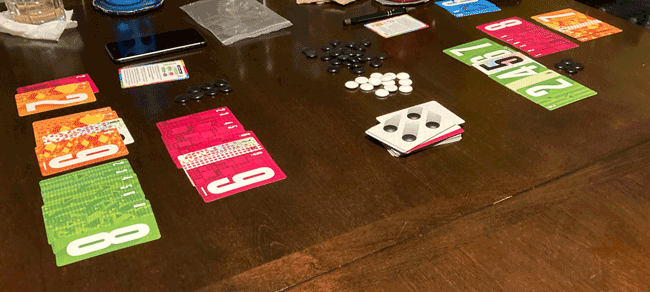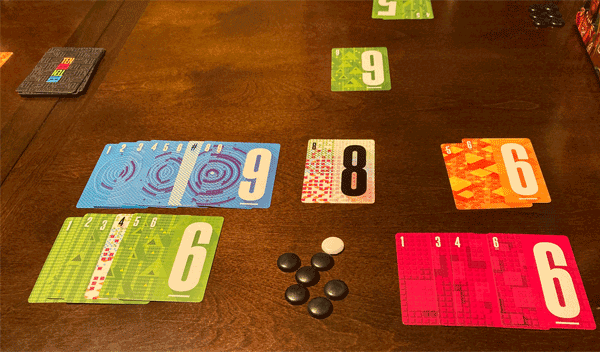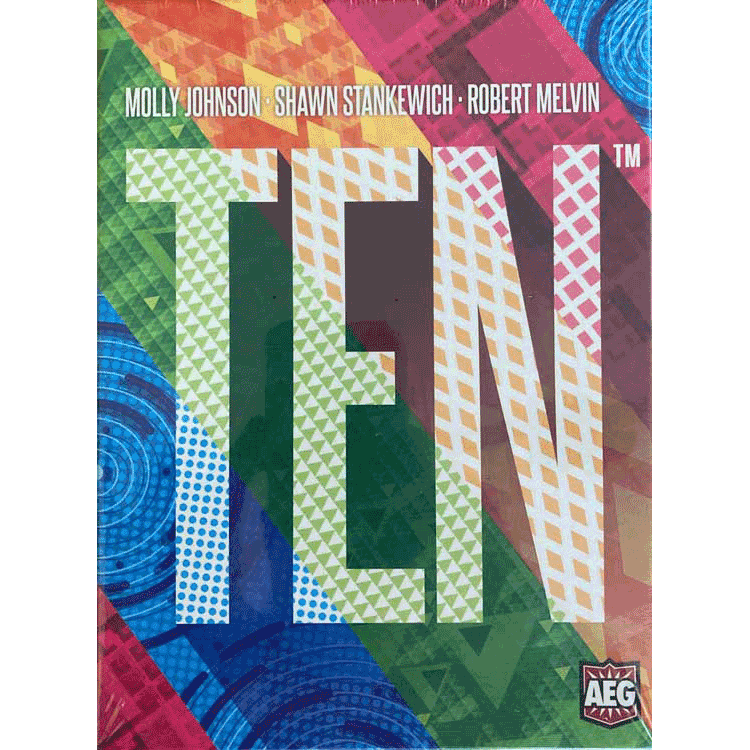TEN is a game published by Alderac Entertainment Group. The premise of the game is for players to gather sequences of numbers in each card color. Players do this by revealing cards one by one and press their luck to procure as many cards as possible in a single turn without busting. The game end is triggered once the last card in the deck is drawn. The player with the most points is declared the winner.
This post is broken into the following 3 sections, feel free to jump directly to one:
- General summary - consisting of information about overall enjoyment, theme, replayability, and upgrades
- Complexity - consisting of information about the rulebook, setup, player turns, and overall learning curve
- Player turns - consisting of game type, game flow, rule you are likely to miss, and favorite aspect
General Summary
Number of players we had: 4
Our play time (not including setup): 40 minutes
Overall enjoyment

Overall our group really enjoyed playing this game. TEN is easy to learn, quick to set up and engages all players throughout the game. This is also a great, portable game that is easy to teach to new players and is appropriate for any player group.
One thing that makes TEN so much fun is the unpredictability created by the press-your-luck approach. Players reveal cards one at a time and can add them to their existing cards as long as they choose to take them before busting. Every card is either a number or currency card. Currency cards reduce the total of the value of the number cards. But watch out, you can bust from both number and currency cards if their combined value rises too high. When players take number cards before busting, all other players receive the value of any currency cards revealed that turn.
If we had to pick something that frustrated us about this game it would be that collecting an entire set of numbers in a color set is only worth one additional point! It is so hard to get an entire set it seems like accomplishing this should provide a bigger bonus!
Theme

The theme of this card game is all about collecting number sequences in each color. While this is a simple game, without a game board, player boards, minis, etc., the artwork is really outstanding. Each number card comes in one of four colors - orange, blue, green and magenta - each of which is very bright and has its own unique design in the background.
When you put each set of colored cards in numerical order, a larger design is created. So while the game is simple, there was definitely a lot of time and effort put into creating the designs for each color and set of cards.
Replayability

TEN is a decently replayable game for a few reasons. First, it is easy to teach new players, can be set up and put away quickly, and it only takes 30-45 minutes to play. This will obviously be dependent upon who you are playing with. As with any push-your-luck game, some players will be highly decisive while others, not so much.
Second, no two games will ever be the same for several reasons. Every player presses their luck differently, the cards are going to be randomly shuffled, and the wild cards add an additional element of unpredictability because you never know when one will show up.
Lastly, auctions are randomly triggered by revealed wild cards that can help a player fill a gap they might not otherwise get. However, players cannot just sit back collecting currency so they have more than other players while they wait for that one card because there is a limit to the amount of currency players can have. This is probably one of the best rules of the game as it constantly levels the game for everyone.
Instead of hoarding currency, players' must decide when to hold on to currency, and potentially skip gaining more currency for free on other players turns, and when to spend it on wild cards and cards at the market knowing this will potentially cause them to miss out on another important card. As a result, an auction can happen when you have a lot of currency, or when you are broke, and there is no way to predict this.
Another nice thing about TEN is that it scales well. Depending upon how many players you have, some cards may be removed. These cards are easy to find as they have symbols in the bottom right corner that do not take away from the game experience at all.
Upgrades
I am not aware of any upgrades for this game.
Complexity
Rule book
The rule book is short, well organized and easy to follow. There are images and examples of play and how the game works. Additionally, the back page of the rule book is a quick reference guide and there are player aides as well.
Setup
TEN takes about five minutes to set up. Each player gets a reference card, the game cards are shuffled and currency and bust tokens are set where every player can access them. At this point, you are ready to begin playing.
Turns
Player turns go quickly because each player follows the exact same steps on their turn and each player can benefit from other players' turns. On their turn, players reveal a new card and can continue to do so until they bust or no longer want to press their luck. A player busts if the total of the number values on revealed number cards or currency cards hits 11 or more. However, when a currency card is revealed, it reduces the total value of the revealed number cards, allowing players to further push their luck.
If a player busts, they receive a bust token worth three currency, which does not count towards the currency limit of 10. Additionally, all number cards move to the market area where players can acquire them on later turns, where they did not bust, by paying their face value. If a player busted due to number cards, all other players collect the total value of any currency cards they also revealed that turn.
When players successfully end their turn without busting, they have the opportunity to purchase any one number card at the market by paying the value of the number on that card using currency, bust tokens, duplicate number cards or any combination of these.

Overall learning curve
The overall learning curve of this game is very low. Players count number and currency cards on their turn and do their best to acquire the missing numbers in each color sequence in their possession.
Player Turns
Play type
TEN is a symmetrical, press-your-luck set collection card game that also has some auction and bidding elements. Players are working to create as many complete sets of numbered cards from 1-9 in each color. At the end of the game, players receive points for the longest spans of sequential numbers in each color group and a bonus for each complete set.

Game flow
The flow of this game is quick considering players reveal cards one at a time until they either bust, or take the revealed number cards or revealed currency and then purchase an optional market card. TEN is engaging for all players at all times since other players' turns often benefit them.
When players bust, other players gain the total value of all currency cards revealed (up to the 10 limit), and number cards are added to the market for later purchase. Cards moving to the market can change a player's game if a card they need ends up there. Specifically, they will play their next hand in a much more reserved manner so they can be sure to prevent busting and then have the option to buy the card from the market (assuming they have enough currency of course).
Rule you are likely to forget/miss
The only rule we forgot was to take a white bust token when we busted. I think this was simply because of the push-your-luck strategy and the tension naturally built during each player's turn as they approach busting.
Favorite aspect
We love the press-your-luck aspect of this game and how the currency cards drop the total of the number cards. Also, it is nice that even if a player busts, they at least acquire a bust token they can use later to purchase cards at the market or in an auction. Also, even though a player can only have ten currency tokens, bust tokens do not count towards this limit so players can in fact have higher than 10 currency and players need to keep this in mind when bidding on an auctioned card.
TEN is a beautiful and clever card game that is easy to learn, plays quickly, has a small footprint and will be on our game shelves for a long time to come.


